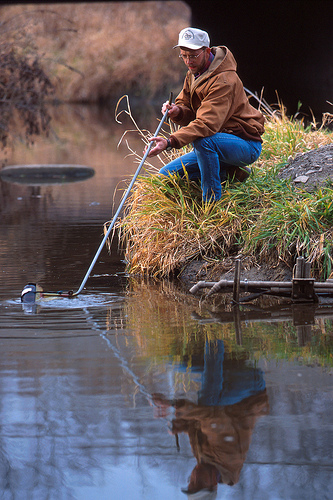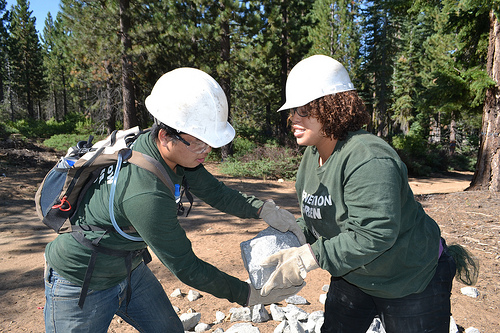
ARS Technician Jeff Nichols collects a water sample from the Walnut Creek watershed in Ames, Iowa.
This post is part of the Science Tuesday feature series on the USDA blog. Check back each week as we showcase stories and news from the USDA’s rich science and research portfolio.
From ensuring the sustainability of our water resources, to breeding crops tolerant to changing climactic conditions, to preparing for the increased food demands of 9 billion people by 2050, finding solutions to the biggest agricultural challenges we face will require a new level of scientific innovation, coordination and long-term planning. As Iowa State University’s College of Agriculture and Life Sciences Associate Dean Joe Colletti recently put it, ag science is not rocket science – it’s more complicated than rocket science! Read more »

Simon Vu and Angel Winston, members of the YCC Watershed Crew and recent high school graduates, work together to line a Zuni Bowl with stones. Zuni Bowls help stabilize erosion and maintain soil moisture.
The Central California Consortium (CCC) celebrated the completion of its intern program at the 16th Annual Intern Awards Ceremony. CCC partner, Center for Advanced Research and Technology (CART), hosted the event on August 9, 2012 in Clovis, CA. The CCC was honored to host USDA and Forest Service leadership, as well as over 125 guests comprised of Forest Service staff, community partners, and family members. Read more »
The recently concluded South Dakota State Fair is ‘Still the One!’ The Value Added Agriculture Development Center (VAADC) hosted Value Added Ag Day at the 2012 South Dakota State Fair on August 30th. USDA Rural Development was represented at the tent and State Director Elsie Meeks was on a panel discussion titled Growing Rural South Dakota. The discussion was focused on the respective businesses and their development and expansion of agribusiness ventures that have brought value to our agricultural producers and local-state economies. Meeks spoke on the long term partnership and support our agency has provided to the Center, provided examples of business and cooperative programs offered through USDA Rural Development, as well as USDA celebrating its 150th anniversary. Participants were able to view the timeline posters displayed inside the tent.
The Value Added Agriculture Development Center and its member contingency of rural-based commodity groups, trade organizations and cooperatives provide education and technical assistance to individuals, groups and communities. Read more »

The Student Conservation Association hiked into the Cruces Basin Wilderness this summer to do some basic trail maintenance. This involved lifting and moving rocks and breaking ground to make the trail easier to hike.
Imagine traveling 2,000 miles from home for the first time to trade high-rise buildings for towering trees, city lights for twinkling stars, and an urban cacophony for the melodies of songbirds.
For most of us, this would be a vacation. For six Baltimore teenagers, it was a journey to work long, hard days to restore the wilderness character of the Carson National Forest in New Mexico. Read more »
Every summer Native American, Alaska Native, and Native Hawaiian college students from across the nation come to the U.S. Department of Agriculture’s Animal and Plant Health Inspection Service (APHIS) as participants in the program Washington Internships for Native Students (WINS); I am one of them. For some of us, interning at APHIS is the first time we have ever lived off our tribal lands. For others, coming to Washington, D.C. is but another experience living in a big city. All of us, however, are linked in some way to the tribal communities we represent: the Omaha, Chippewa, Mohawk, Lumbee, Quechan, Laguna and Isleta nations.
WINS interns contribute more than just our skills and time; we add our voices. We speak as individuals from communities that are often underrepresented in government settings. We come to APHIS from states such as California, Nebraska, Oklahoma, and New Mexico and carry with us the unique perspectives of peoples from distant lands. Our respective cultures and histories, stories and languages are irrevocably parts of who we are and contribute to the way we view the world. WINS interns help bridge the gap between Washington’s governmental agencies and the people for whom they work. In the “People’s Department,” this bridge is priceless. Read more »

One of the SuperTracker team members, Sarah Chang, nutritionist, enthusiastically demos the SuperTracker site. Photo by Sasha Bard
The Agriculture Department announced this week that SuperTracker, an interactive diet and activity tracking tool, reached one million registered users. SuperTracker, maintained by the USDA Center for Nutrition Policy and Promotion (CNPP), is a free online application. Users can choose from a wide variety of features ranging from quickly looking up the nutrient information for a food to in-depth diet and activity tracking. For example, users can track their vegetable intake, estimate how many calories they burn in their aerobics class, and track their weight loss over time. Read more »




